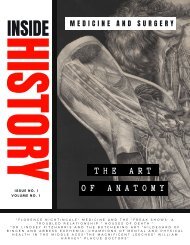Inside History: A History of Film (Sample)
Join Inside History as we talk a closer look at The History of Film. From its humble origins to creating some of the world's most iconic moments. Along the way we will also look at how some films can flop at the box office only to become classics later, explain why Casablanca just might be the greatest War film of all time and how the silent era inspired even modern film makers. From Lon Chaney to Marilyn Monroe and John Williams we explore not only what happened on screen but also those behind the scenes who have played a part in some of the greatest movies of all time. With essays on: George Melies, Casablanca, The Cabinet of Dr Caligari, Psycho, Leni Riefenstahl, Warner Brothers, Ealing Studios, Lon Chaney, Frankenstein and much more. Full edition is available at www.insidehistorymagazine.ecwid.com
Join Inside History as we talk a closer look at The History of Film. From its humble origins to creating some of the world's most iconic moments. Along the way we will also look at how some films can flop at the box office only to become classics later, explain why Casablanca just might be the greatest War film of all time and how the silent era inspired even modern film makers.
From Lon Chaney to Marilyn Monroe and John Williams we explore not only what happened on screen but also those behind the scenes who have played a part in some of the greatest movies of all time.
With essays on:
George Melies, Casablanca, The Cabinet of Dr Caligari, Psycho, Leni Riefenstahl, Warner Brothers, Ealing Studios, Lon Chaney, Frankenstein and much more.
Full edition is available at www.insidehistorymagazine.ecwid.com
Create successful ePaper yourself
Turn your PDF publications into a flip-book with our unique Google optimized e-Paper software.
As one of the greatest pioneers of the film industry, George
Méliès was the first to explore the realm of fantasy and fiction
in narrative film. As a well-established French illusionist, he
took an experimental approach to the new world of cinema,
making use of innovative editing tricks and optical illusions to
create special effects, never imagined on film. He paved the
way for narrative film with the creation of his most successful
film, the iconic Le Voyage dans la Lune / A Trip to the Moon
(1902).
A Trip to the Moon is a 14-minute narrative film, which follows
a group of scientists as they embark upon their expedition to
the moon. The black and white film was produced on a
budget of ₣10,000 and favoured wide camera angles to give
the impression of a theatre performance. It is no surprise,
considering Méliès background, that this silent film was
intended to be accompanied by a narrator and musical
special effects at the discretion of the exhibitor.
Professor Barbenfouillis – played by Méliès – first approaches
a room of astronomers dressed in clothing, which resemble
that of a magician. When sharing his ideas on the board via a
diagram of a capsule being launched from earth, a discussion
erupts and only a small group agree to join him. As the
scientists embark on their journey, they are fired from a
canon and crash directly into the eye of the Man in the Moon.
This iconic scene remains an important part of cinematic
history as it demonstrates how Méliès was able to manipulate
the camera with the use of special effects.
Shortly after arriving on the moon, the group settle down and
begin to experience an array of dreams. They wake to a storm
caused by Phoebe, Goddess of the Moon, and begin to
explore the unusual vegetation growing around them. As they
venture around the new world, they are confronted and
eventually captured by a group of indigenous beings - the
Selenites. They are taken to the leader and proceed to use
violence to escape capture. Upon their descent, a Selenite
clings to the capsule. As the scientists return to Earth, they
are greeted by a celebratory crowd as the Selenite is paraded
around and abused with the use of ropes and sticks.
Méliès knew his audience and used the contemporary
attitudes surrounding science, exploration, and colonisation
to create a visual narrative people would enjoy and loosely
understand. His time as an anti-Boulangist cartoonist for
L’Illusionnise and Passez Muscade magic magazines surely
influenced the satirical nature of the film.
Méliès immediately became interested in film as a medium
upon the invention of the cinématographe by the Lumière
brothers in 1895, allowing films to be projected to audiences
for the first time. Méliès was among the attendees as the
brothers held a private demonstration of their invention at
their Parisian home on 28th December 1895. He was
infatuated by the possibilities that it presented and
promptly offered to buy one of the machines. The brothers
wanted to keep control of their invention for the time being
but Méliès was hooked and set about finding another
projector for his theatre. He managed to purchase a more
rudimentary animatograph from British film pioneer Robert
W. Paul, which he then modified to also function as a film
camera.
Early films typically displayed documentary-style snippets of
everyday life and didn’t run longer than a couple of minutes.
Méliès initially started to experiment with the same type of
film, as he began shooting and screening films at his theatre -
Théâtre Robert-Houdin - in 1896. He quickly began to
show an affinity for spectacle and fantasy with some of his
INSIDE HISTORY 09

















